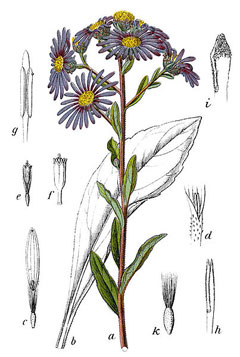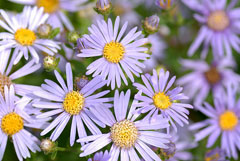 |
|
http://commons.wikimedia.org/wiki/File:Aster_amellus_Sturm6-cropped.jpg |
 |
| http://commons.wikimedia.org/wiki/User:Aka |
Translate this page:
Summary
Physical Characteristics

 Aster amellus is a PERENNIAL growing to 0.7 m (2ft 4in) by 0.5 m (1ft 8in).
Aster amellus is a PERENNIAL growing to 0.7 m (2ft 4in) by 0.5 m (1ft 8in).
See above for USDA hardiness. It is hardy to UK zone 5 and is not frost tender. It is in flower from September to October, and the seeds ripen in October. The species is hermaphrodite (has both male and female organs) and is pollinated by Bees, flies, beetles, Lepidoptera (Moths & Butterflies). The plant is self-fertile.
Suitable for: light (sandy), medium (loamy) and heavy (clay) soils, prefers well-drained soil and can grow in nutritionally poor soil. Suitable pH: mildly acid, neutral and basic (mildly alkaline) soils. It cannot grow in the shade. It prefers moist soil.
UK Hardiness Map
US Hardiness Map
Synonyms
A. amelloides. Besser. A. trinervius. Roxb.
Plant Habitats
Cultivated Beds;
Edible Uses
Edible Parts: Leaves
Edible Uses:
Leaves and young plants - cooked[177]. Only certain varieties (not specified in the report) are used[177]. A nutritional analysis is available[218].
References More on Edible Uses
| Composition
|
| Figures in grams (g) or miligrams (mg) per 100g of food.
|
|
|
Leaves (Dry weight)
|
|
- 305 Calories per 100g
- Water : 0%
- Protein: 32.8g; Fat: 5.5g; Carbohydrate: 50g; Fibre: 8.6g; Ash: 11.7g;
- Minerals - Calcium: 328mg; Phosphorus: 594mg; Iron: 31mg; Magnesium: 0mg; Sodium: 0mg; Potassium: 4164mg; Zinc: 0mg;
- Vitamins - A: 26mg; Thiamine (B1): 1.41mg; Riboflavin (B2): 2.81mg; Niacin: 8.59mg; B6: 0mg; C: 688mg;
- Reference: [ ]
- Notes:
|
|
Medicinal Uses
Plants For A Future can not take any responsibility for any adverse effects from the use of plants. Always seek advice from a professional before using a plant medicinally.
Antiinflammatory Antitussive Depurative Haemostatic Malaria Pectoral
The roots are anti-inflammatory, antitussive, depurative, haemostatic and pectoral[61, 147].They are used in the treatment of coughs, pulmonary affections and malaria[240]. The root juice is used internally in Nepal to treat indigestion and externally to treat boils[272].
References More on Medicinal Uses
The Bookshop: Edible Plant Books
Our Latest books on Perennial Plants For Food Forests and Permaculture Gardens in paperback or digital formats.

Edible Tropical Plants
Food Forest Plants for Hotter Conditions: 250+ Plants For Tropical Food Forests & Permaculture Gardens.
More

Edible Temperate Plants
Plants for Your Food Forest: 500 Plants for Temperate Food Forests & Permaculture Gardens.
More

More Books
PFAF have eight books available in paperback and digital formats. Browse the shop for more information.
Shop Now
Other Uses
References More on Other Uses
Cultivation details
Succeeds in most good garden soils[1], preferring one that is well-drained and moisture retentive[200]. Tolerates poorer soils[233]. Prefers a sunny position[200] but also succeeds in part shade[233]. Plants are hardy to about -25°c[187]. A very ornamental plant[1], there are some named varieties[233]. A polymorphic species[50], it hybridizes freely with other members of this genus[200]. Most species in this genus seem to be immune to the predations of rabbits[233].
References Carbon Farming Information and Carbon Sequestration Information
Temperature Converter
Type a value in the Celsius field to convert the value to Fahrenheit:
Fahrenheit:
The PFAF Bookshop
Plants For A Future have a number of books available in paperback and digital form. Book titles include Edible Plants, Edible Perennials, Edible Trees,Edible Shrubs, Woodland Gardening, and Temperate Food Forest Plants. Our new book is Food Forest Plants For Hotter Conditions (Tropical and Sub-Tropical).
Shop Now
Plant Propagation
Seed - surface sow in spring in a cold frame. Do not allow the compost to become dry. Pre-chilling the seed for two weeks can improve germination rates[134]. The seed usually germinates in 2 weeks at 20°c[134]. When large enough to handle, prick the seedlings out into individual pots and plant them out in the summer. Division in spring or autumn[200].
Other Names
If available other names are mentioned here
Native Range
TEMPERATE ASIA: Turkey (northeast), Armenia, Azerbaijan, Georgia, Russian Federation (Dagestan), Russian Federation (Chelyabinsk), Kazakhstan EUROPE: Austria, Czech Republic, Germany, Hungary, Poland, Slovakia, Russian Federation (European part), Moldova, Ukraine (incl. Krym), Albania, Bulgaria, Bosnia and Herzegovina, Greece (possibly), Croatia, Italy, North Macedonia, Montenegro, Romania, Serbia, Slovenia, France
Weed Potential
Right plant wrong place. We are currently updating this section.
Please note that a plant may be invasive in one area but may not in your area so it's worth checking.
Conservation Status
IUCN Red List of Threatened Plants Status :

| Related Plants
|
| Latin Name | Common Name | Habit | Height | Hardiness | Growth | Soil | Shade | Moisture | Edible | Medicinal | Other |
| Achillea ageratum | Mace, Sweet-nancy | Perennial | 0.6 |
6-9
| | LMH | N | DM | 2 | 0 | |
| Achillea erba-rotta moschata | Musk Milfoil | Perennial | 0.2 |
5-9
| | LMH | N | DM | 0 | 2 | |
| Achillea millefolium | Yarrow, Boreal yarrow, California yarrow, Giant yarrow, Coast yarrow, Western yarrow, Pacific yarrow | Perennial | 0.6 |
4-8
| F | LMH | SN | DM | 3 | 4 | 4 |
| Achillea ptarmica | Sneeze-Wort, Sneezeweed | Perennial | 0.6 |
3-9
| F | LMH | N | M | 2 | 1 | 2 |
| Achillea santolina | | Perennial | 0.3 |
-
| | LMH | N | DM | 0 | 1 | 1 |
| Achillea sibirica | Siberian Yarrow | Perennial | 0.5 |
5-9
| | LMH | N | DM | 1 | 1 | |
| Acmella oleracea | Toothache plant, Paracress | Perennial | 0.4 |
9-11
| F | LMH | N | M | 3 | 3 | 2 |
| Acourtia microcephala | Sacapellote | Perennial | 1.4 |
7-10
| | LM | N | DM | 0 | 1 | |
| Actinea acaulis arizonica | | | 0.0 |
-
| | LMH | SN | M | 0 | 0 | |
| Ageratina altissima | White Snakeroot, Richweed | Perennial | 2.0 |
5-9
| | LMH | SN | M | 0 | 2 | 0 |
| Ageratina aromatica | | Perennial | 1.5 |
4-8
| | LMH | SN | M | 1 | 1 | |
| Ageratina herbacea | Fragrant Snakeroot | Perennial | 2.0 |
5-9
| | LMH | SN | M | 0 | 1 | |
| Ageratina ligustrina | | Shrub | 5.0 |
9-11
| | LMH | N | M | 0 | 0 | |
| Ageratina occidentalis | Western Snakeroot | Perennial | 0.7 |
5-9
| | LMH | SN | M | 0 | 1 | |
| Ageratina rugosum | | | 0.0 |
-
| | LMH | SN | M | 0 | 0 | |
| Ageratum conyzoides | Goatweed, Tropical whiteweed | Annual | 1.0 |
8-11
| | LMH | N | M | 0 | 3 | 2 |
| Ageratum houstonianum | Ageratum, Bluemink, Floss Flower, Garden | Annual | 0.3 |
0-0
| M | LMH | N | DM | 0 | 1 | |
| Agoseris aurantiaca | Mountain Dandelion, Orange agoseris | Perennial | 0.6 |
0-0
| | Lm | N | DM | 3 | 1 | 0 |
| Agoseris glauca | Mountain Dandelion, Pale agoseris, False agoseris | Perennial | 0.6 |
0-0
| | Lm | N | DM | 3 | 1 | 1 |
| Agoseris retrorsa | Spearleaf Agoseris | Perennial | 0.3 |
4-8
| F | LM | SN | DM | 3 | 0 | 1 |
| Ambrosia artemesiifolia | Roman Wormwood, Bitterweed, Blackweed, Carrot Weed, Hay Fever Weed, Stickeweed, Tassel Weed, Wild Ta | Annual | 0.9 |
4-8
| M | LMH | SN | M | 2 | 3 | 1 |
| Ambrosia confertiflora | Slimleaf Bursage | Perennial | 1.5 |
8-11
| M | LM | N | DM | 1 | 0 | 0 |
| Ambrosia trifida | Giant Ragweed, Great ragweed, Texan great ragweed, Bitterweed, Bloodweed, Buffalo Weed, Horse Cane | Annual | 2.0 |
1-11
| M | LMH | SN | M | 1 | 3 | 1 |
| Anacyclus pyrethrum | Mount Atlas Daisy, Chamomile Spanish, Pellitory | Perennial | 0.3 |
5-7
| M | LM | N | M | 0 | 2 | |
| Anaphalis margaritacea | Pearly Everlasting, Western pearly everlasting | Perennial | 0.9 |
3-7
| | LM | SN | DM | 1 | 2 | 1 |
| Antennaria dioica | Catsfoot, Stoloniferous pussytoes | Perennial | 0.1 |
4-8
| | L | N | DM | 0 | 2 | 2 |
| Antennaria parvifolia | Littleleaf Pussytoes | Perennial | 0.2 |
3-8
| F | LM | SN | DM | 1 | 0 | 2 |
| Antennaria rosea | Rosy Pussytoes | Perennial | 0.2 |
3-8
| F | LM | N | DM | 1 | 0 | 2 |
| Anthemis arvensis | Corn Chamomile | Annual | 0.4 |
4-8
| | LMH | N | DM | 0 | 2 | 2 |
| Anthemis cotula | Mayweed, Stinking chamomile | Annual | 0.6 |
4-8
| | MH | N | DM | 1 | 2 | 1 |
|
|
Growth: S = slow M = medium F = fast. Soil: L = light (sandy) M = medium H = heavy (clay). pH: A = acid N = neutral B = basic (alkaline). Shade: F = full shade S = semi-shade N = no shade. Moisture: D = dry M = Moist We = wet Wa = water.
Now available:
Food Forest Plants for Mediterranean Conditions
350+ Perennial Plants For Mediterranean and Drier Food Forests and Permaculture Gardens.
[Paperback and eBook]
This is the third in Plants For A Future's series of plant guides for food forests tailored to
specific climate zones. Following volumes on temperate and tropical ecosystems, this book focuses
on species suited to Mediterranean conditions—regions with hot, dry summers and cool, wet winters,
often facing the added challenge of climate change.
Read More
Expert comment
Author
L.
Botanical References
50200
Links / References
For a list of references used on this page please go here
Readers comment
| Add a comment |
|
If you have important information about this plant that may help other users please add a comment or link below. Only comments or links that are felt to be directly relevant to a plant will be included. If you think a comment/link or information contained on this page is inaccurate or misleading we would welcome your feedback at [email protected]. If you have questions about a plant please use the Forum on this website as we do not have the resources to answer questions ourselves.
* Please note: the comments by website users are not necessarily those held by PFAF and may give misleading or inaccurate information.
To leave a comment please Register or login here All comments need to be approved so will not appear immediately.
|
|